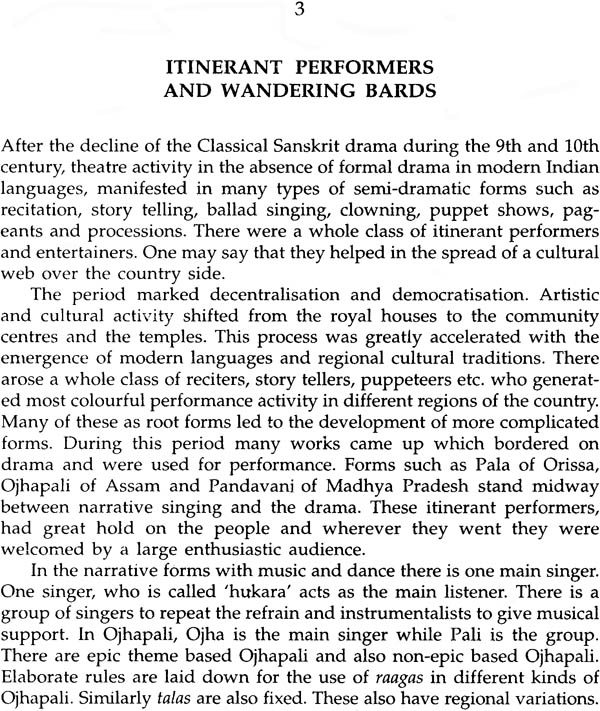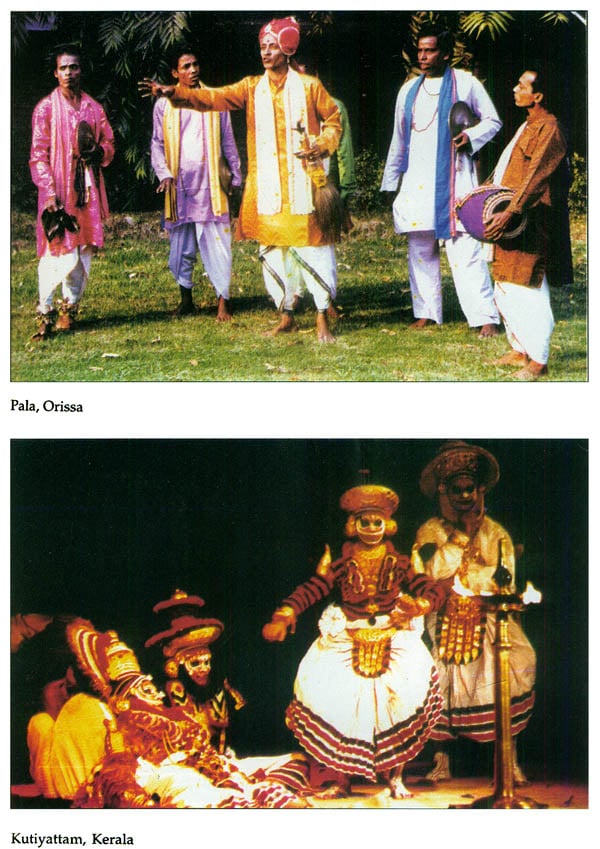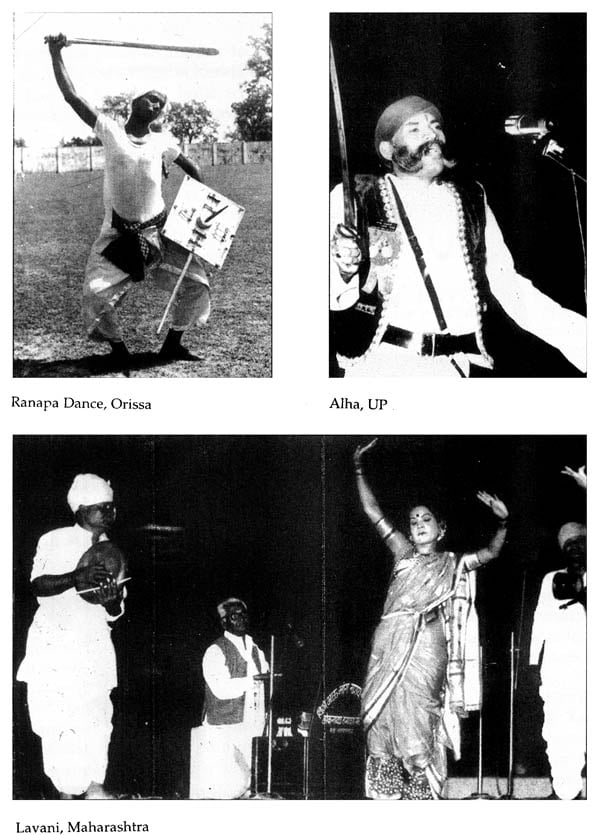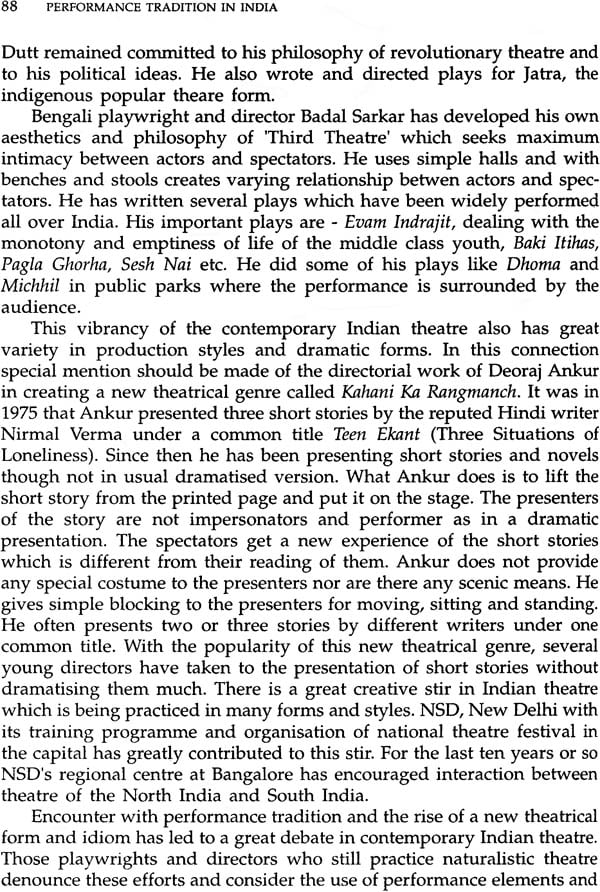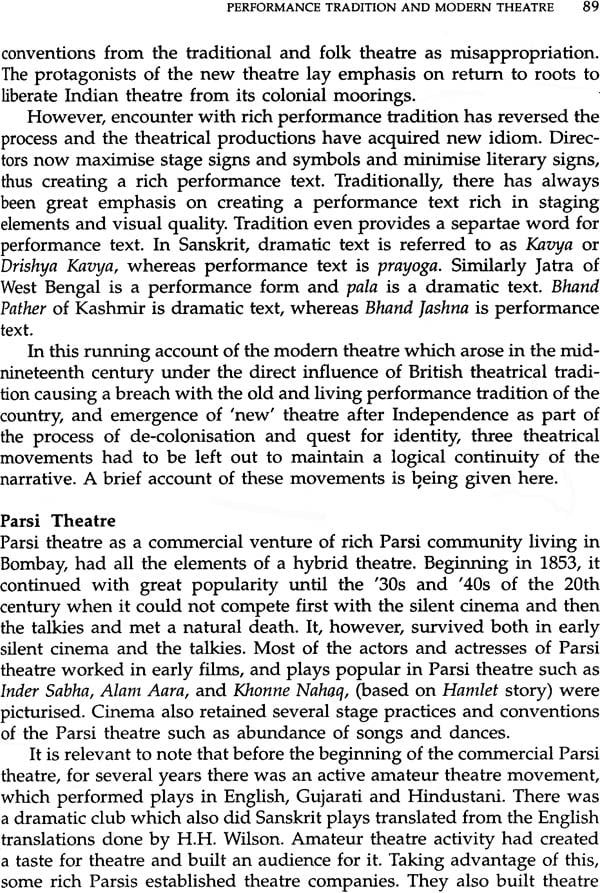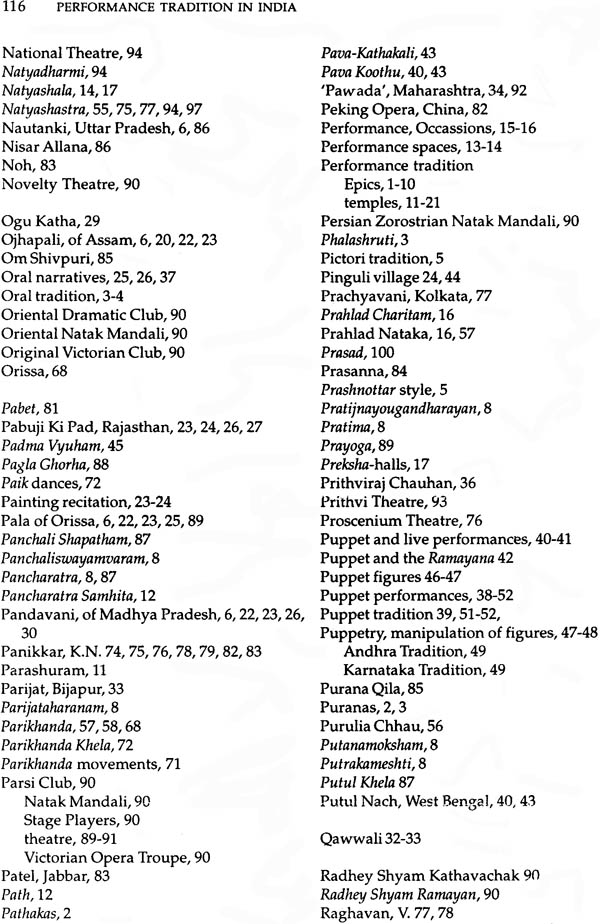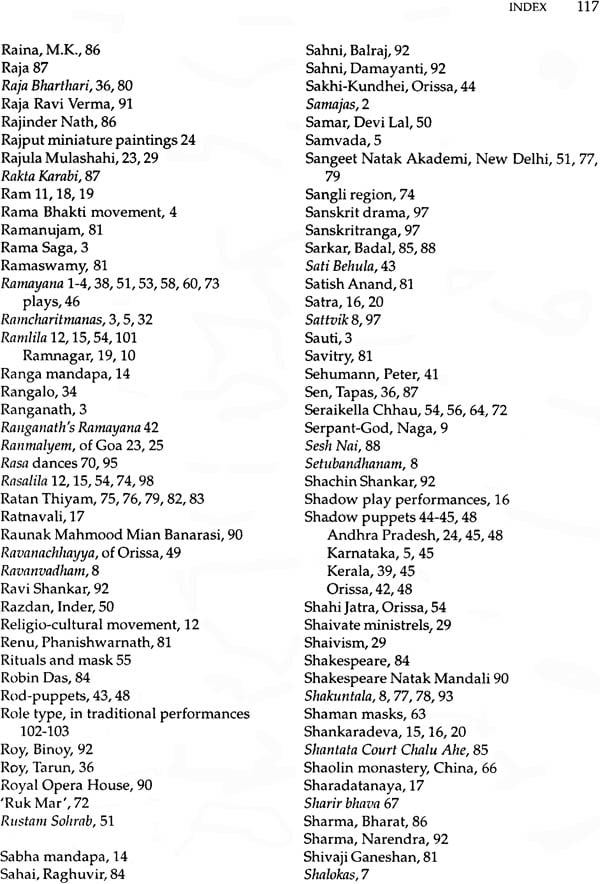
Performance Tradition in India
Book Specification
| Item Code: | NAL980 |
| Author: | Dr. Suresh Awasthi |
| Publisher: | National Book Trust, India |
| Language: | English |
| Edition: | 2018 |
| ISBN: | 9788123736181 |
| Pages: | 144 (23 Color and 14 B/W Illustrations) |
| Cover: | Paperback |
| Other Details | 9.0 inch X 7.0 inch |
| Weight | 140 gm |
Book Description
The book gives a comprehensive account of various art forms as practised in different corners of India almost as a way of life. Written in a lucid style, different aspects of 6the rich performance tradition of the country with is own typical myths, customs, traditions and folk life get unraveled before us in these pages. Tracing the tradition of performing arts to the times when the performance of the two epics and the puranas were the only source of entertainment and outlet for creative energy, the book goes on to discuss the rise and fall of the Sanskrit classical theatre, and other art forms viz.; the masks, puppets martial arts, the wandering bards down to the multi-faceted progress of the modern theatre after the independence. Profusely illustrated with black and white as well as well colour, it is a significant contribution to the writings on the performing arts and an important key to the soceo-cuitural understanding of country.
Dr. Suresh Awasthi (1918-2004), a noted scholar of folk and traditional theatre of India, wrote both in Hindi and English on the subject for nearly five decades. As Secretary, Sangeet Natak Akademi (1965-1975), he sponsored folk and traditional performing troupes both for the general public and for documentation. He had been Visiting Professor (1975-81) in different universities in the USA, and a Visiting Research Professor (1981) I Tokyo University which brought out a publication of ten lectures given by him on Indian theater under the title Drama: The of Gods. The National School of Drama, an organization he also served as its Chairman (196published a selection of his Hindi essays on various aspects of Indian theatre under the title Hey Samajik. He was also awarded with Sahityakaar Sammam by Hindi Akademi, Delhi, Government, for his contribution to the theatrical literature.
Initially I was offered by the National Book rust to write a book on the folk drama of India. I could not begin the work on the book for sometime became of other writing assignments. Later, the Director of the Trust realized that they have already got published a book on traditional and folk theatre of India which had discussed all the forms in detail. I was then asked to submit the plan of the book on different lines. I decided to write the book on the performance tradition of India discussing certain important themes. I chose eight themes to be treated on a pan-India basis.
It has been difficult to write this book as I was afflicted with Parkinson disease within two years of the assignment. The authorities of the Trust, specially the Editorial staff and particularly Chief Editor Dr. the Vardh Das have been most considerate. I am greatly obliged to them.
My wife, Induja, has been a great support during my illness and helped and encouraged me in completing the book.
I am also thankful to my Steno-cum-computer operator Sunil Kumar, who has worked with dedication in preparing the manuscript.
Beginning with the epic tradition to the rise of ‘new contemporary theatre, the book deals with various aspects of the performance tradition of India. The theme of the first chapter is Epics and the Performance tradition. Epics have played a very important role in Indian performance tradition. Epics provide thematic material to many forms. Their growth through the continued tradition and story telling became the root forms of Indian performance tradition. Many traditional forms prevalent in different regions of the country have strong epic orientation and their structure follows the format recitation and telling. Even in highly evolved forms like Kathakali of Kerala and Yakshagan of Karnataka the entire dramatic text is recited and sung by two reciters-singers in case of Kathakali, and one recite-singer in Yakshagan. The performance them taken the effect of a dramatization of the recited and sung text with recitation forming a king a kind of baseline.
The theme of the second chapter is Temple and the Performance Tradition. After the breakdown of the classical Sanskrit theatrical tradition in the 10th century A.D., the drama found a place in the temple in the16th century A.D., Temple provided a variety of performance spaces, in the form of both built structures and open spaces. Temple drama, as a matter of fact, arose from the devotional singing, religious congregations and the spread of Vaishnavism which generated a great cultural movement. Saint poets wrote poetry charged with the sentiment of devotion which provided text for temple drama. Forms like Ramlila and Raslila evolved in North India. In South India, Kutiyattam, the only performing tradition of Sanskrit drama, had already marked the beginning since the 10th century. It later found a place in Vishnu temples and was performed in specially built theatres called Kutambalam. Temples received patronage from Kings. Similarly, Kathakali also grew during the 16th-17th century and found patronage from the temples and the Kings.
The third chapter deals with the theme of Itinerant Performers and Wanering Bards who proliferated after the breakdown of the Sanskrit drama and built a most colorful variety theatre in early medieval centuries Puppeteers, acrobats, story-tellers, balladiers, impersonators, reciters and picture showmen are some of the itinerant perdformers. It is interesting to note that the great poet Jaidev (12th century who wrote immortal lyrico-dramatic poem Geet-Govinds called himself a wandering bard. His poetic work has exerted great influence since them on all performing literary and pictorial arts. Geet Govinda provided model for Krishnattam and other forms of Kerala. Krishnattam dealing with the life of Krishna in eight cycle plays found place in the Vishnu temple at Guruvayur. Temple gave drama a large devoted audience, rich poetry, stirring music and imposing architectural background.
The next chapter of the book deals with the Puppets and Puppet Performances. India is considered to be the home of puppetry and according to some scholars puppets have been the source of origin of drama in India. In any case, puppetry in India has a great antiquity. Its metaphorical references are found in early Buddhist text and in both the epics – the Ramayana and the Mahabharata. Almost all forms of puppets can be found in India being practiced in different regions of the country and the whole tradition is closely linked with the Ramayana tradition. The oldest and richest tradition is that of the shadow puppets prevalent in Orissa, Andhra Pradesh and Karnataka. The shadow puppets prevalent in the countries of South-East Asia with Ramayan as their theme owe their origin to the Indian puppet tradition. In this chapter, I have discussed all the aspects of puppet tradition, namely the making of puppets, their manipulation, various conventions and stories preformed.
The theme of the next chapter of the books is Masks and Masked Dances. India is very rich in mask culture and mask performances. The main streams of masked performance are the Buddhist dance and tribal rituals performed with dance. Masks are also used evil and demonic characters in other forms. Krishnattam, the classical form, also uses masks for several demonic characters. Most interesting masks made in a variety of materials are those of Lord Ganesh, the elephant headed god, Hanuman, the monkey general of Rama’s army, and Narsimha, the half man-half lion icarnation of god Vishnu. Similarly Chhau dances prevalent in the three states of Jharkhand, previously part of Bihar, West Bengal and Orissa in the eastern region are performed with all dancers wearing masks. However, in Orissa with Mayurbhanj being the main centure, Chhau dancers generally do not use masks. Seraikela in Jharkhand (previously in Bihar) and Purulia in West Bengal are the centres for such styles of Chhau in which all the characters wear masks. These dances and the masks have been discussed in great detail in the chapter.
Another important theme of the discusses Tradition of Martial Arts in Relation to the Performance tradition. It is a phenomenon of Indian, infact, Asian performances tradition, that there are several performance modes which have either originated from the martial arts or have been greatly influenced by them. The tradition of martial arts is prevalent in Manipur in Thang-Ta, and in Kerala in Kalaripayatt, also referred to as Kalari. Kathakali has taken over several training exercises from Kalari. It has also taken over special massage system for Kalari trainees.
Seventh theme of the book deals with Performance Tradition and the Emergence of Modern Theatre in the mid 19th century under the direct influence of British dramatic and theatrical tradition. It began in Calcutta, the seat of British power. I conclude this chapter with modern theatre following the emergence of ‘New’ theatre after independence which brought back several elements of performance tradition. This resulted in the rehabilitation of music, dance and poetry which were exiled during the naturalistic theatre generated by the colonial rule. I also discuss the work of several directors, both who are practicing new theatre which has been called ‘Theatre of Roots’, and also those who continue to practice theatre of naturalistic idiom.
Last chapter of the book deals with the Aesthetic Principles and Practice of Performance Tradition, which were laid down by Bharata in his Natyashastra, a treatise on the theory and practice of drama. The aesthetics and practice is also determined by the performing conditions space etc.
This book thus attempts to give a panoramic view of the performance tradition of the country.
| Preface | ix | |
| Introduction | xi | |
| 1 | Epics and the Performance Tradition | 1 |
| 2 | Temple and the Performance Tradition | 11 |
| 3 | Itinerant Performers and Wandering Bards | 22 |
| 4 | Puppets and Puppet Performances | 38 |
| 5 | Masks and Masked Dances | 53 |
| 6 | Martial Art and Performance Tradition | 64 |
| 7 | Performance Tradition and Modern Theatre | 73 |
| 8 | Performance Tradition: Aesthetic & Practice | 94 |
| Glossary | 105 | |
| Bibliography | 109 | |
| Index | 111 |
